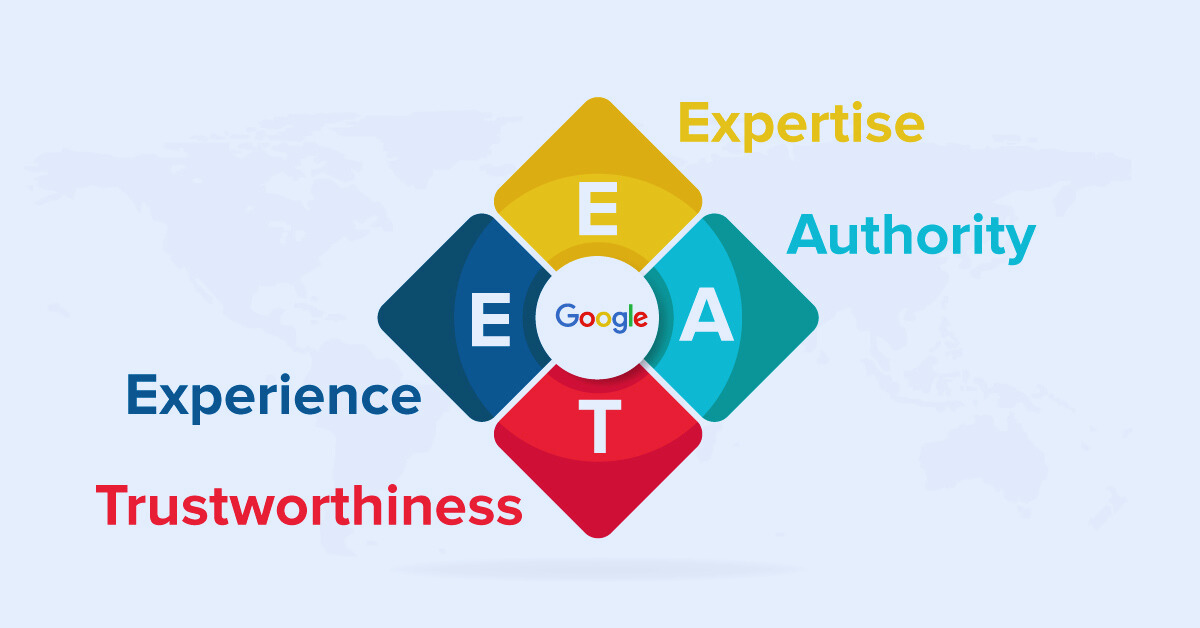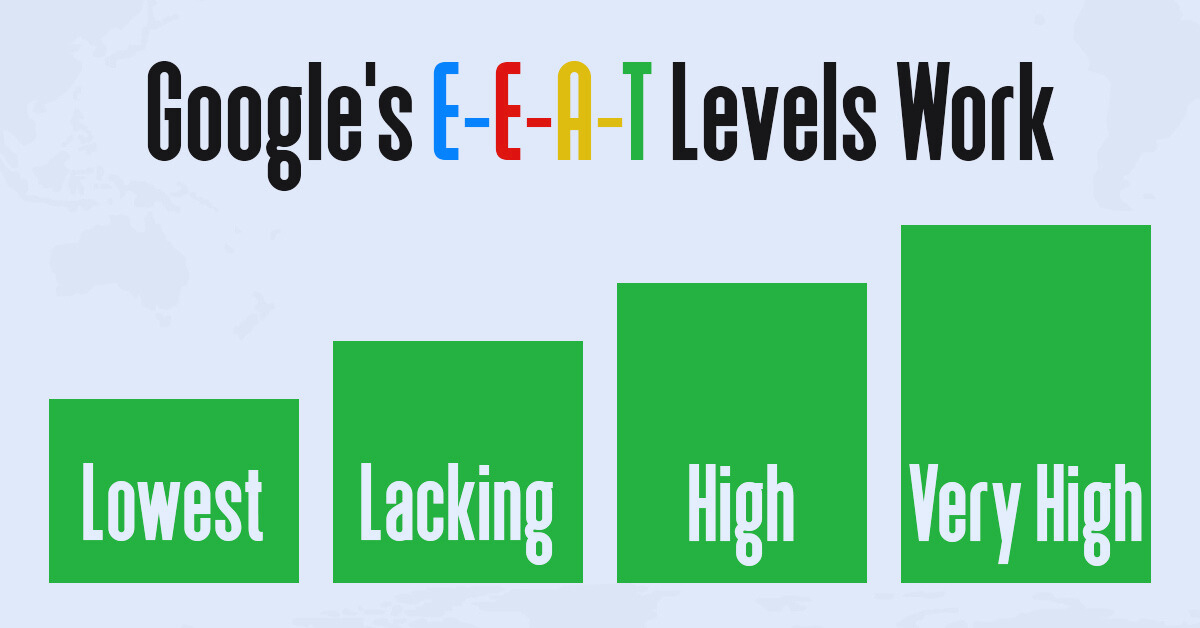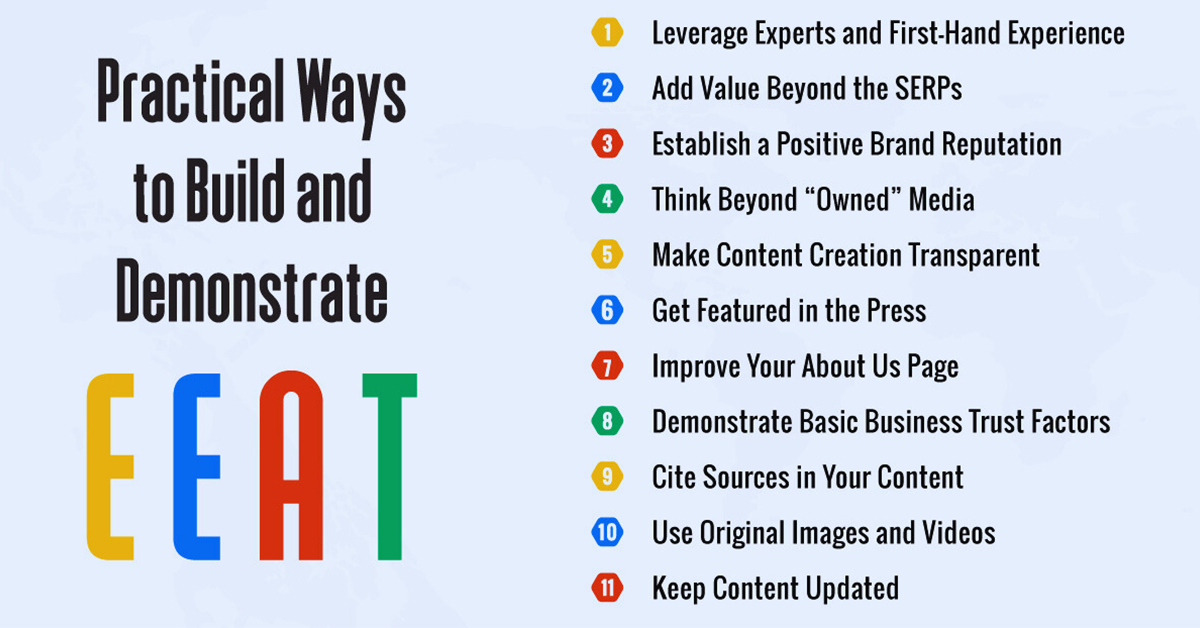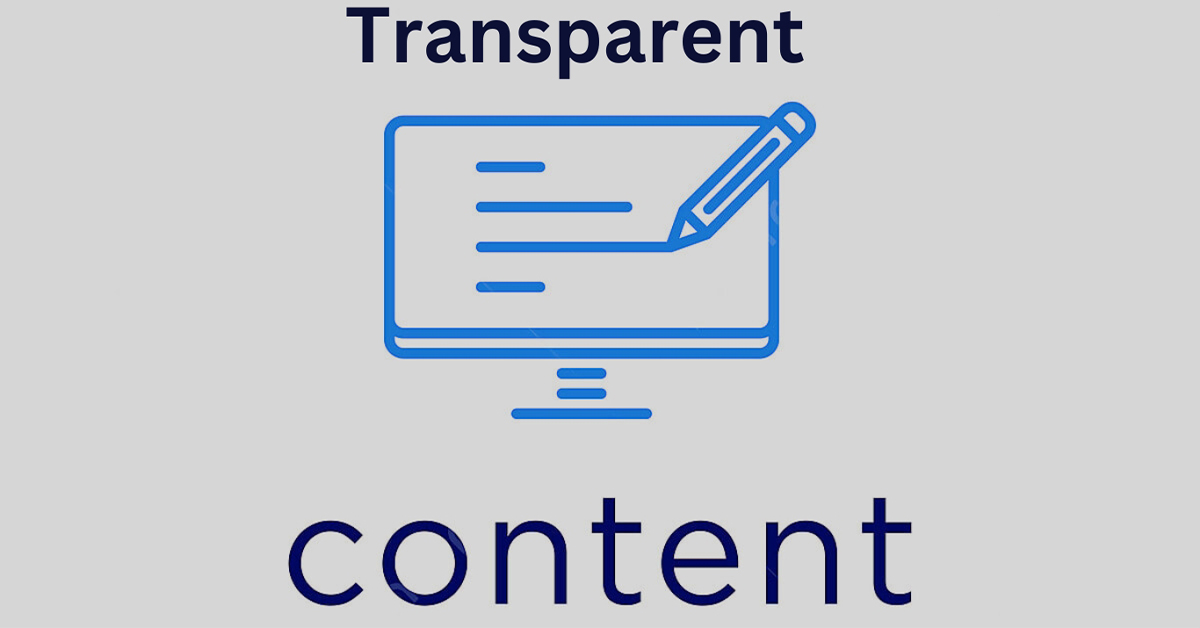After the recent updates, Google promised that a site cannot only rank with the power of backlinks and other matrices. The site must help the readers in every way by covering necessary pieces of information.
The Google E-E-A-T framework stands for Experience, Expertise, Authoritativeness, and Trustworthiness and is a framework used by Google to evaluate content.
It assesses that the content creator must contribute relevant content and expose his or her expertise in this sector. This helps Google decide how strong this site's E-E-A-T is.
This blog post is about how E-E-A-T can transform your content strategy by debunking common myths, explaining its importance in today's digital landscape, and offering practical ways to implement it effectively.
Google E-E-A-T: Exposing Myths

Google's E-E-A-T concept often must be clarified among website creators and marketers. Let's clarify some common misunderstandings so you can understand what it is really for.
Myth #1: E-E-A-T Isn’t a Ranking Factor
A common misconception is that E-E-A-T directly impacts the ranking of your website. E-E-A-T operates differently.
- Not a Direct Ranking Factor: E-E-A-T is not a ranking factor like keywords or backlinks that directly affect your website.
- A Quality Benchmark: Google uses E-E-A-T as a guideline to assess the quality of content. It helps ensure that content meets a high standard worldwide.
- Focus on Trust: Creating reliable and helpful content is a great way to establish trust with your audience.
Myth #2: E-E-A-T Doesn't Have Checklists
I know some people think E-E-A-T is a simple checklist, but it's a lot more complicated.
- Dynamic and Flexible: E-E-A-T adapts based on the type of content and the audience's needs. It is not a one-size-fits-all solution.
- Experience Matters: The additional "E" in E-E-A-T stands for Experience, emphasizing the value of firsthand knowledge and personal insights.
- On-site and Off-site Signals: Being E-E-A-T means showing your expertise and trustworthiness both on and off-site.
E-E-A-T: Why It Matters?
A digital age requires quality content. Users trust Google's E-E-A-T guidelines for credible, authoritative, and trustworthy web content. The importance of E-E-A-T.
Increased User Trust and Engagement
E-E-A-T plays a vital role in establishing user trust. Content written by experts or those with firsthand experience is more likely to be accurate and reliable. This authenticity keeps readers engaged and coming back for more. Key points include:
- Content by experts builds credibility.
- You're more likely to share content if you're engaged.
- Trustworthy content improves user experience.
Impact on Search Engine Results
E-E-A-T helps Google to decide which content deserves a top spot in search results. Content with high E-E-A-T scores is more likely to appear in these spots, helping websites gain visibility. Here’s why it matters:
- A higher E-E-A-T score translates into better rankings.
- Quality content meets search engine criteria.
- Google rewards expertise and reliability.
Building a Reliable Online Presence
A strong online presence depends on trust and authority. E-E-A-T helps websites gain a reputation for quality and trustworthiness. This is crucial for long-term success. Consider the following:
- Credible sites attract more visitors.
- Trust boosts brand reputation.
- Reliable content ensures sustained traffic.
E-E-A-T is vital for producing quality content that gains user trust, performs well in search engines, and builds a strong online reputation.
Core Elements of E-E-A-T

E-E-A-T is composed of four elements, each of which is explored in more detail below.
Experience: Bringing Authenticity to Content
A content creator's experience is based on direct, personal involvement with the topic. It adds a layer of authenticity that AI cannot replicate. Here's how the experience might look:
- Hotel Reviews: Write about a hotel you have actually stayed in.
- Book Recommendations: Suggesting books you have personally read.
- Product Reviews: Testing products yourself before discussing them.
Your involvement should be clearly expressed in order to showcase your experience. Here's how:
- Use Personal Media: Share your own photos and videos instead of generic images.
- Express Personal Insights: Include your thoughts on what you liked or didn't like.
- Detail Unique Aspects: Mention specifics that only someone with personal experience would notice.
Your content becomes more credible and resonates with more people by doing this.
Expertise: Establishing Authority and Trust
Your expertise is the knowledge and skills you bring to your content. It is especially important in fields such as medicine and finance. The following is how expertise is defined:
- Qualifications: Formal education or certifications in the subject.
- Experience: Years of practice or deep engagement with the topic.
- Reputation: Recognition within a field as a knowledgeable source.
To build and show expertise, consider the following:
- Highlight Author Credentials: Include the qualifications and achievements of the content creator.
- Provide Expert Reviews: Show that experts have reviewed your content for accuracy.
- Use Reliable Sources: Support your statements with data from credible sources.
Content with evident expertise not only builds trust with your audience but also aligns with Google's standards.
Authoritativeness
An authoritative source of information is one that can be trusted as a reliable source. Just like how ESPN is known for sports and the Financial Times for finance, your website can be an authority, too.
How to Become Authoritative:
- Backlinks: Get links from other credible sites. This shows that others trust your content.
- Strong Reputation: Build a good name in your field.
- Expert Authors: Have writers who are well-known experts.
- Comprehensive Content: Cover all parts of a topic thoroughly.
Building Authoritativeness:
- Use tools to find which sites link to your competitors and try to earn those links.
- Create content that fills in gaps or offers more value than what's already out there.
- You should regularly update your content to keep it current and useful.
Trustworthiness
Honesty and safety are essential components of trustworthiness. You must prove to readers and Google that your information is reliable.
Why Trust Matters:
- Pages with important information like finance should be especially trustworthy.
- Misinformation can negatively affect readers and decrease your site's reputation.
How to Build Trust:
- Clear Contact Info: Make it easy for users to reach you with clear contact details.
- Updated Content: Regularly refresh your content and show the last update date.
- Secure Transactions: Use SSL certificates to protect users' data during transactions.
- Positive Feedback: Display reviews and handle feedback well.
How Google's E-E-A-T Levels Work?

Google uses the E-E-A-T algorithm to determine the quality of web pages. These levels can determine a page's credibility and reliability. Let's explore the different levels of E-E-A-T and how they impact website quality.
Lowest E-E-A-T
The lowest E-E-A-T pages can be considered unreliable and spammy. You might find these pages:
- Lack of Credibility and Trust: They need to provide accurate and trustworthy information.
- Provide Misleading or Harmful Information: They might contain false claims or dangerous advice.
- Engage in Fraudulent Activities: These pages could be involved in scams or illegal activities.
Such pages are easy to spot and should be avoided as they can harm users.
Lacking E-E-A-T
The pages that lack E-E-A-T may belong to a generally reputable site, but they may go off-topic on specific topics. An example would be:
- Off-Topic Content: A fitness blog with a random post about guitars, which doesn't align with the site's expertise.
- Lack of Expert Knowledge: Content not supported by expert knowledge or relevant experience.
They're not harmful, but they show a lack of expertise.
- Poorly Written Content: Content that lacks originality, effort, or skill.
- Misleading Titles: Titles that exaggerate or mislead the reader.
- Distracting Ads: Ads that take attention away from the main content.
High E-E-A-T
High E-E-A-T pages are recognized for their solid experience and expertise. They typically:
- Deliver Well-Researched Content: Information is backed by thorough research and expert insights.
- Build a Positive Reputation: The site or author is known for reliability and quality.
- Present Clear Knowledge of Their Subject: They demonstrate a deep understanding of the topic.
A page like this meets its purpose well and is trusted.
Very High E-E-A-T
Pages with extremely high E-E-A-T are at the top of the trust scale. These include:
- Content Created by Recognized Experts: Authors with proven expertise and experience in the field.
- Websites Known as Authorities on a Subject: Sites that are widely recognized as leading sources of information.
These pages are the most reliable sources on the web. To achieve this level, consider:
- Highlighting First-Hand Experience and Expertise: Showcasing the author's direct experience and knowledge.
- Providing Detailed Author Information: Offering transparency about the author's credentials and background.
- Building Trust Through Consistent, High-Quality Content: Maintaining a standard of excellence across all content.
11 Practical Ways to Build and Present E-E-A-T

You need to gain Google's trust by demonstrating Expertise, Authoritativeness, and Trustworthiness (E-E-A-T). To achieve this, here are some effective strategies.
Leverage Experts and First-Hand Experience
It's important to choose the right people to create content for your website. This should ideally be someone with expertise and experience in the topic.
- Identify Expertise: Look within your business for experts who have deep knowledge about the topic.
- Engage Spokespersons: Decide who will represent your brand on specific subjects.
- Gather Insightful Contributions: Involve experts in reviewing, providing quotes, and identifying knowledge gaps in competitor content.
Avoid anonymous content. Readers want to connect with the person behind the words, not just a generic "admin" or "marketing" label.
Add Value Beyond the SERPs
Many online articles simply rephrase existing content. To stand out, provide unique insights that fill in the gaps left by others.
- Information Gain: Introduce new and valuable information to the topic.
- Expert Feedback: Have your experts review top-ranking content and suggest areas that are lacking.
- Topical Authority: Ensure your content covers the topic comprehensively to become a go-to resource.
You can enhance your site's authority and attract more visitors by offering something unique.
Establish a Positive Brand Reputation
You build trust with your audience when you have a solid brand reputation. It is possible for negative perceptions to have the opposite effect.
- Collect Reviews: Ask your customers to leave reviews on platforms such as Yelp, Trustpilot, and Google.
- Respond to Feedback: Positive as well as negative reviews should be addressed. Respond transparently to negative comments and thank users for positive feedback.
- Showcase Reviews: You should make testimonials prominent on your site in order to help build trust.
Your brand is more trustworthy if you actively manage reviews.
Think Beyond Owned Media
You can only reach a limited number of people by focusing solely on the content of your website. Your E-E-A-T can be greatly enhanced by expanding your media presence.
- Guest Appearances: You may participate in relevant podcasts to share the insights you have gained in your work.
- Webinars: You can co-host webinars in order to share your expertise with the audience and build a relationship with them.
- Conferences: Speak at industry events to build credibility and visibility.
You will build your reputation as a result of these activities.
Make Content Creation Transparent

Readers should easily identify who created the content and understand their qualifications. Transparency builds trust.
- Author Profiles: Create detailed author profile pages. Include:
- Personal and professional background.
- Profile picture.
- Areas of expertise.
- Contact information.
- Authored posts and press features.
- Schema Markup: Use Schema markup to provide search engines with author details and profiles.
Authorship transparency assures readers that the content is credible.
Get Featured in the Press
You can improve your E-E-A-T by being featured in reputable publications. Your brand and experts is reliable voices as a result.
- Digital PR: Take advantage of opportunities to provide insights to journalists through digital PR.
- Industry Spokesperson: Establish yourself as a key source of information for media outlets covering your industry.
- Gain Credible Links: Getting mentioned in the press often comes with links back to your site, enhancing your authority.
Your E-E-A-T will improve, as will the publications' content reliability.
Improve Your About Us Page
Your About Us page introduces your brand to visitors. You can tell your story and describe what makes your business special here.
- Brand Story: Share your journey and what sets you apart.
- Products and Services: Highlight what you offer.
- Unique Selling Proposition (USP): Explain why customers should choose you.
- Meet the Team: Introduce the people behind your brand.
- Awards and Accreditations: Showcase recognitions and memberships.
- Customer Testimonials: Include reviews and feedback.
- Locations and Contact Info: Provide your physical locations and how to reach you.
Your About Us page should build trust and connect with your audience.
Demonstrate Basic Business Trust Factors
A website for a business should have certain trust factors for visitors. Reliability and transparency are ensured by these basic principles.
- Policies: Include terms and conditions, privacy, cookie, and returns policies.
- Delivery Information: Clearly outline shipping details.
- Contact Information: Make your phone number, email, and address easy to find.
It's an easy way to let visitors know your business is legit and trustworthy.
Cite Sources in Your Content
Credibility depends on the citation of sources. Your information is more trustworthy if you use it.
- Reference Data: Clearly state where your facts and statistics come from.
- Link to Sources: Provide links to original studies or articles.
- Transparency: If using your own data, make it explicit.
Your content can be more credible by citing sources to back up your claims.
Use Original Images and Videos
Your website's credibility can be greatly enhanced by creating your own visual content. It shows that you've personally experienced what you're discussing.
- Authenticity: Use your own photos and videos as opposed to stock images.
- Smartphone Usage: High-quality images can be captured with a smartphone. No need for a professional photographer.
- Personal Touch: Original media adds a personal touch and authenticity to your content.
You demonstrate your direct experience and knowledge of the topic when you showcase genuine images.
Keep Content Updated
A topic's authority can be maintained by keeping your content fresh and current. It is possible to lose trust when information is outdated.
- Regular Reviews: Schedule content reviews at least once a year, ideally every six months.
- Timely Updates: Update information as it changes to ensure accuracy.
- Visible Review Dates: Display the date when the content was last updated to reassure readers of its relevance.
Your readers will be able to trust your information if it is regularly updated.
Conclusion
The four pillars of a robust online presence, which we explored in part one, are experience, expertise, authoritativeness, and trustworthiness. By embracing these elements, you can enhance user trust, improve search engine rankings, and strengthen your credibility. Mastering E-E-A-T takes continuous effort and adaptation.
Collaboration with industry experts, original content creation, or simply ensuring your site reflects your brand integrity are all steps toward a people-first approach. When you enthusiastically pursue these strategies, you will be amazed at how much your online influence grows.

